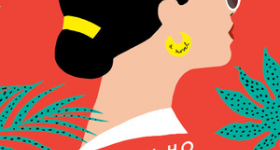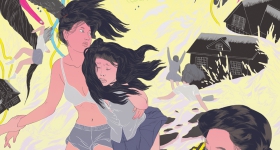IF YOU WERE WONDERING what happened to the pluralism of the '90s, it hasn't gone away. It's just mutated.
While for many artists starting their second decade, melding and multiplicity are concepts easily enough abandoned, there are a few, like my friend Jenifer Wofford, who've built a practice on those bones.
The articles that have proliferated about her recently either disagree about what she is, or employ aggressive forward slashes: artist/teacher/curator/organizer. But then she's a multiracial third-culture kid - someone who spent a significant amount of time in one or more cultures that are not her birth culture, and combined aspects of these various cultures into a "third culture" - and a quintessential San Francisco Bay Arean; i.e., she cannot herself be defined without the language of pluralism. Her artwork is easily recognizable as Woffordesque, and easily enough described, yet impossible to categorize.
Take her most recent piece, an installation at San Francisco's Southern Exposure gallery this February called Unseen Forces. A meditation on control of access to imagined paradises, the installation takes up the entire back gallery of the space, comprising two life-sized metal detectors, a four-wall mural of a tropical island landscape infiltrated by monolithic grey structures and a luxury shopping mall scene.
Despite the suggested jungle landscape, the installation is not about lushness or multiplicity. What you notice most in this piece is the open space-the smooth, flat planes available on every surface.
Wofford is a minimalist who loves profusion. Getting into her influences is an exercise in simultaneous revelation and further confusion. She name-checks cubistw sculptor Louise Nevelson, quirk-amole dot-painter Yayoi Kusama, Phyllis Madonna of the kitsch palace Madonna Inn in San Luis Obispo, CA, and... lmelda Marcos.
You'll feel you're finally getting somewhere when she goes back to the beginning of her involvement in the arts: a childhood spent as a goofy theater geek. Wofford is definitely a ham. Hang out with her for a night and you'll realize that Unseen Forces is, as much as anything, a painted stage set.
The performing artist she was becoming in school plays in Hong Kong, Dubai and Malaysia, where her family pursued her father's engineering career, turned into something else in her teens when they moved back to the Bay Area. That was a turning point. The theater kids in her "scary-ass American high school" were all white, and suddenly she didn't belong onstage anymore.
A combination of good visual arts teachers and a best friend who turned her on to underground comics redirected her towards fine arts, and she never looked back. Underground comics? Doonesbury and Tintinl She says, "I learned more from Jaime Hernandez about line quality and how to draw female figures," than she ever learned from a formal education in the classics.
And you can see Love and Rockets, as well as Ghost World, and that "misogynist but... dreamy, dreamy illustrator" Robert Crumb, in Wofford's broken-narrative nurse drawings. Each of these two series, Nurse and Point of Departure, feature the figures of Filipina nurses.
In Nurse we find white-highlighted graphite line drawings, on institutional green paper, of resting nurses, floating nurses, nurses looking out windows. Their bodies are supported or swallowed up by flowing, mattressy blankscapes, and accompanied-or threatened-by geologic/geometric durian-like outcroppings.
Point of Departure's postcard-sized paintings show the nurses-most often half-bodies truncated by perspective-in minimalized institutional environments. These look like frames stolen at random from a color comic book, divested of dialogue balloons.
It's an interesting tactic: stealing techniques from the elegiac male artist of the female form to conduct a feminist investigation of female labor. It's characteristic of Wofford's practice that this technique is misunderstood. Critics have treated Wofford's nurse bodies as "the hulls of a worker," but she says, "I'm bringing attention back to them as people. ... There's a long history of female body as art. Reframing the body as a person is political."
And so is reframing the person in a different cultural context. Wofford feels her heritage gives her an insight into American and immigrant culture that most people don't have: being biracial, having a white dad from a more working class background and a Pinay mom from a more upper class background; growing up in countries whose cultures neither of her parents share; being always in "conditions of difference."
It leaves her "trying to draw connections across difference." In fact, that's her mission in life: to integrate everything she does or has. "It's about having more influences as a woman of color. I grew up without role models, so it's less about me being the center of the universe and more about making it possible for others to have a creative life." It's about showing people art that matters.
To this end, Wofford and 10 of her contemporaries (including me, as observer and reporter) traveled to Manila in the summer of 2007 on the first leg of an ambitious curatorial project she initiated and currently leads. Galleon Trade is a multi-year, international artists exchange, which began with a three-gallery show by American artists of mostly Filipino and Mexican heritage in Manila, and will continue next year with shows in the Bay Area of Filipino and Mexican national artists, rounding out its schedule in 2009 with a trip by all to the galleries of Mexico.
As the name suggests, Galleon Trade follows the route of the old Spanish galleon trade between Manila, northern California, and Acapulco. At a time when the Galleon Traders' careers are beginning to take them to Western "international art" residencies in Tuscany or Brazil, to deliberately organize a conceptual exchange in third world backwaters is... brave? Counterintuitive? Radical? But Wofford, while grateful for her opportunities, is "not interested in the international art scene" in the conventional sense. She's looking for "humor value, imaginative value" and a way "to talk about otherness that isn't corny."
So is she an identity artist?
During the '80s, she says, "there was a lot of identity-based art that was bluntly direct in a way that wasn't interesting as art, so people started staying away from it." On the other hand, from the identity artists' point of view, "anything that doesn't fit tradition is automatically suspect." Wofford, again from a melded viewpoint, thinks that pioneering identity work was "young work that hadn't had time to mature... it's still relevant; I'm not embarrassed by it." But she does feel that work about otherness has to go to a new place, and leave the rigidity of traditional identity art behind without losing the identity... or the art.
Ultimately, Wofford's artistic mission, be it in making her own work or fostering that of others, is "not about achieving stardom, as long as people can find something to connect with outside the commercial world." She commits to hybridity and otherness because "I don't do very well in the absolutes. Politics without creativity is boring, and art without politics is boring."
Claire Light is a co-founder and former editor of Hyphen.









Comments